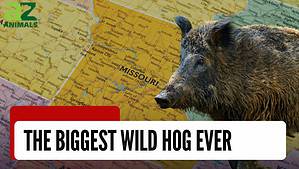Introduction
Great white sharks and grizzly bears are both unarguably formidable in nature. They are both at the top of the food chain in the sea and on land, meaning they are known for hunting and eating various kinds of prey. They are both extremely dangerous to encounter, but one could be more dangerous than the other. We analyze grizzly bears vs. great white sharks, finding which one is worse and why humans might be just as much, if not more of, a threat to them.
Background on Great White Sharks
One bit of information to know about great white sharks is that they are massive. They measure between 15 and 20 feet in length and can weigh more than 3,000 pounds, which is heavier than some cars! In addition, great white sharks have strong tails and can swim within a range of 15 and 35 miles per hour.
Despite their intimidating appearance and speed, great white sharks do not hold the same formidable presence that many people believe. Media has greatly overdramatized the danger of these sharks, and as research on great whites becomes increasingly more detailed and available, their previous terrifying persona begins to fade away. For instance, scientists have recently found great white sharks to be highly intelligent creatures, rather than bloodthirsty monsters. They even have specific body languages that allow them to communicate with others in their species.
The term “white” in their name derives from their white underbellies. They have 300 teeth arranged in up to seven rows. They also have an array of impressive senses. In fact, they have a sixth sense called electro-reception, which allows them to feel electrical currents underwater. Electro-reception helps great white sharks navigate the ocean by feeling the several magnetic fields within the Earth’s crust. Electro-reception also means that they can sense another sea animal’s electromagnetic field. This ability aids the shark in determining where its prey might reside.
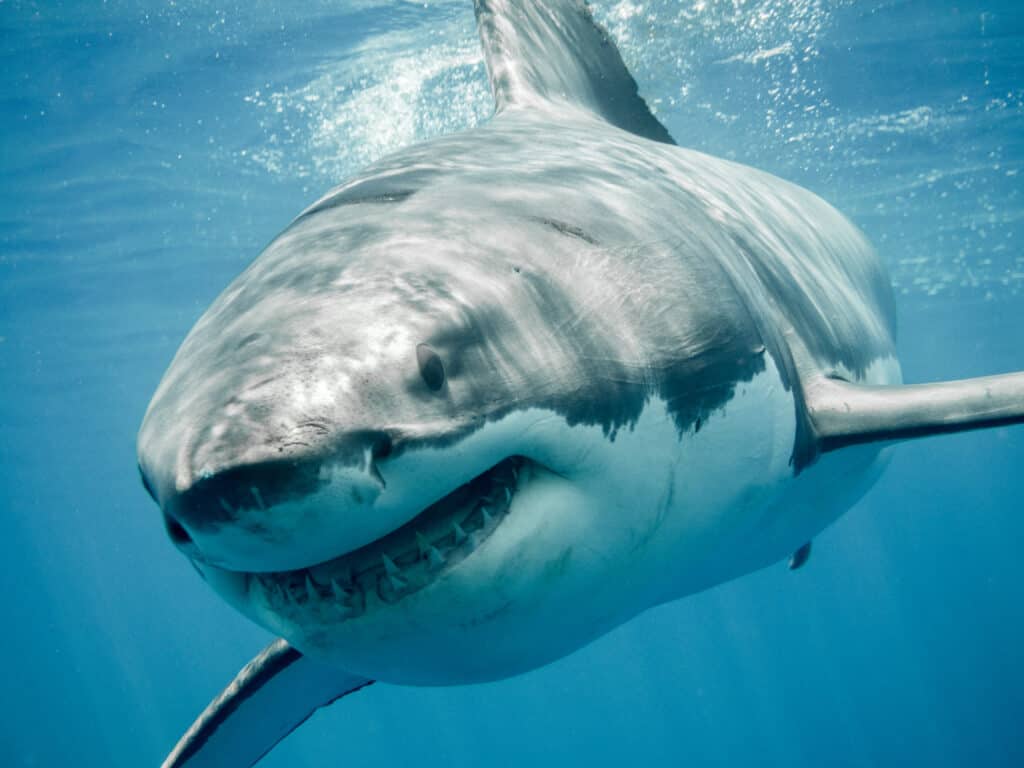
Great white sharks have 300 teeth arranged in up to seven rows.
©Ramon Carretero/Shutterstock.com
Great White Shark Diet and Hunting
While electro-reception might be helpful in guiding a shark to its prey, its sense of smell is even more defined and useful. They can smell even the smallest amount of blood in the surrounding water. This phenomenon is due to their olfactory bulb. The olfactory bulb is an organ that lies within the nostrils. The larger the olfactory bulb, the greater the sense of smell. These sharks have the largest olfactory bulb of any shark species, meaning they have the best sense of smell and, therefore, are excellent hunters.
Their diet consists of a variety of animals such as sea birds, mollusks, crustaceans, and even other shark species. However, the largest great whites hunt for larger prey. These include seals, sea lions, and certain species of whales. In fact, one famous great white shark, named Deep Blue, devoured a massive whale carcass with two of her friends.
Humans are not in the diet of these sharks. In fact, great whites who attack humans are typically confused when they do. Many times, they see a human floating on the surface of the water and mistake it for a seal or other type of prey. Therefore, a great white might attack a human with a quick bite but soon realizes that it made a mistake.
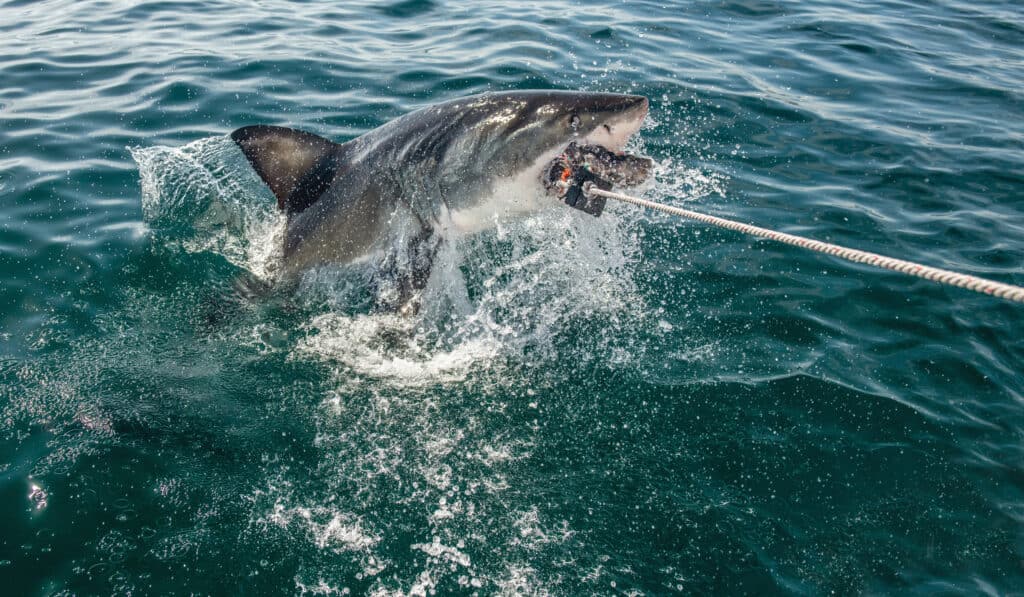
Their diet consists of a variety of animals such as sea birds, mollusks, crustaceans, and even other shark species.
©iStock.com/USO
Great White Shark Dangers and Attacks
Approximately one-third to one-half of annual shark attacks are performed by great whites. While shark victims might believe the attack was intentional and malicious, it probably wasn’t. In fact, this species has been known to only attack humans unprovoked when they confuse them for seals, which is their most sought-after snack. They typically take a bite out of a victim, affirming whether their prey was a seal or not. In cases of shark attacks, the victim wasn’t the prey they were looking for, as sharks will often retreat after the misunderstood bite and hunt for something else. Although shark attacks on humans might not be intentional, they can result in horrible consequences. People have lost limbs and lives to shark attacks, but most attacks are not fatal.
Of the 73 unprovoked shark attacks that occurred in 2021, nine resulted in a fatality. The United States confirmed 47 attacks in 2021, which amounts to 64% of confirmed cases worldwide. Unfortunately, 2021 saw a 42% increase in shark attacks in the United States compared to the previous year. Does this mean shark attacks are increasing? Surprisingly, no. Shark attack occurrences in 2021 strayed from the normal trend. In fact, shark attack occurrences overall have been going down, according to recent trends.
Furthermore, the likelihood of experiencing a fatal shark attack is low, at one in over 4.3 million. To put it into perspective, the chances of dying from fireworks are one in 340,733. Maybe this summer it’s time to stop worrying about shark attacks and ditch the 4th of July fireworks.
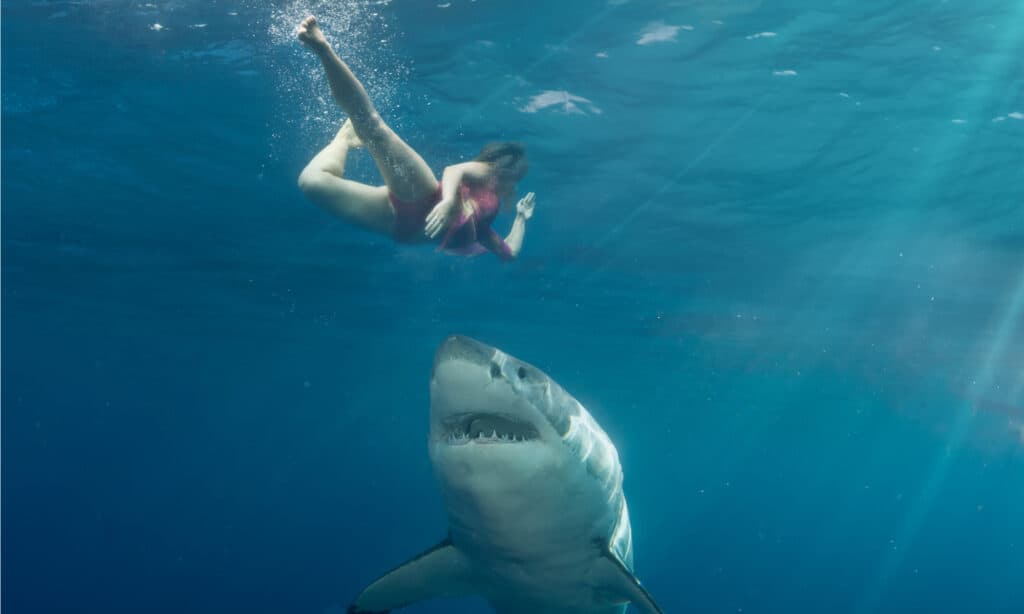
Great whites only attack humans unprovoked when they confuse them for seals
©Willyam Bradberry/Shutterstock.com
Background on Grizzly Bears
The term “grizzly” in the name grizzly bear comes from its appearance. Its hair is grizzled, meaning that it is silver-tipped. Males weigh between 300 and 800 pounds, while females weigh between 200 and 450 pounds. While standing on its hind legs, a male grizzly bear can measure up to 8 feet in height.
Most grizzly bears live in the northwestern portion of the United States. They are not migratory like sharks, though. Instead, they hibernate during the winter. Grizzlies can live between 20 and 25 years on average. However, these bears face many anthropogenic threats. In fact, their population has decreased by approximately 97% since the mid-1800s.
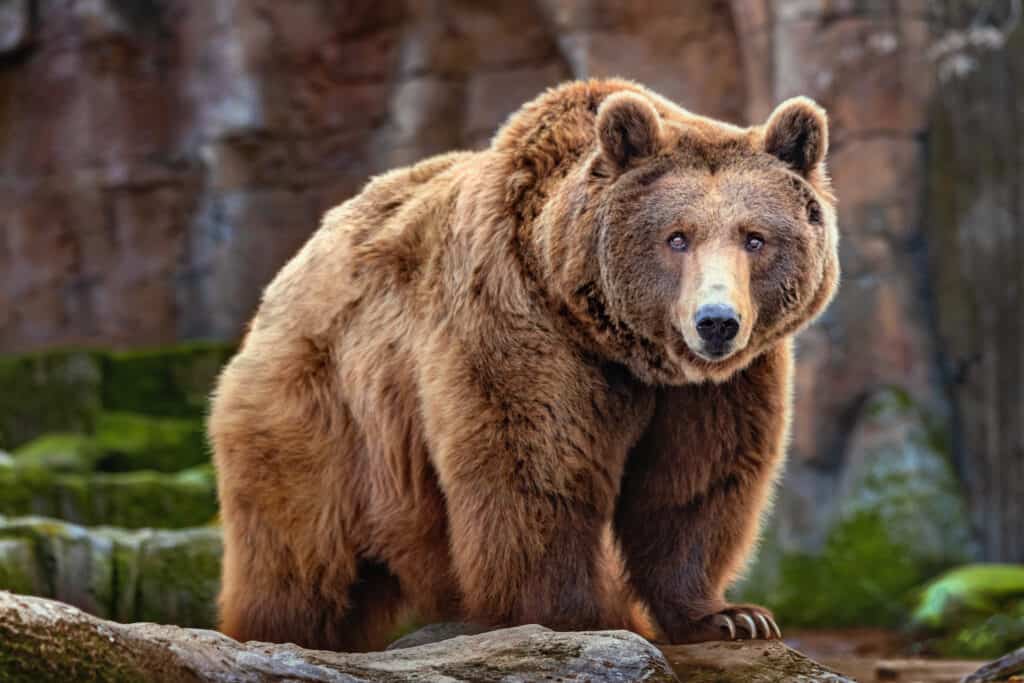
Grizzly males can weigh up to 800 pounds!
©Perpis/Shutterstock.com
Grizzly Bear Diet and Hunting
Grizzlies are not ravenous carnivores as they might appear in the media. In fact, they will eat berries, nuts, and roots alongside various types of meat. They are simultaneously hunters and gatherers. One unique part of their diet is the army cutworm moth. Some grizzly bears in Yellowstone National Park have been known to eat 20,000 army cutworm moths in a single day!
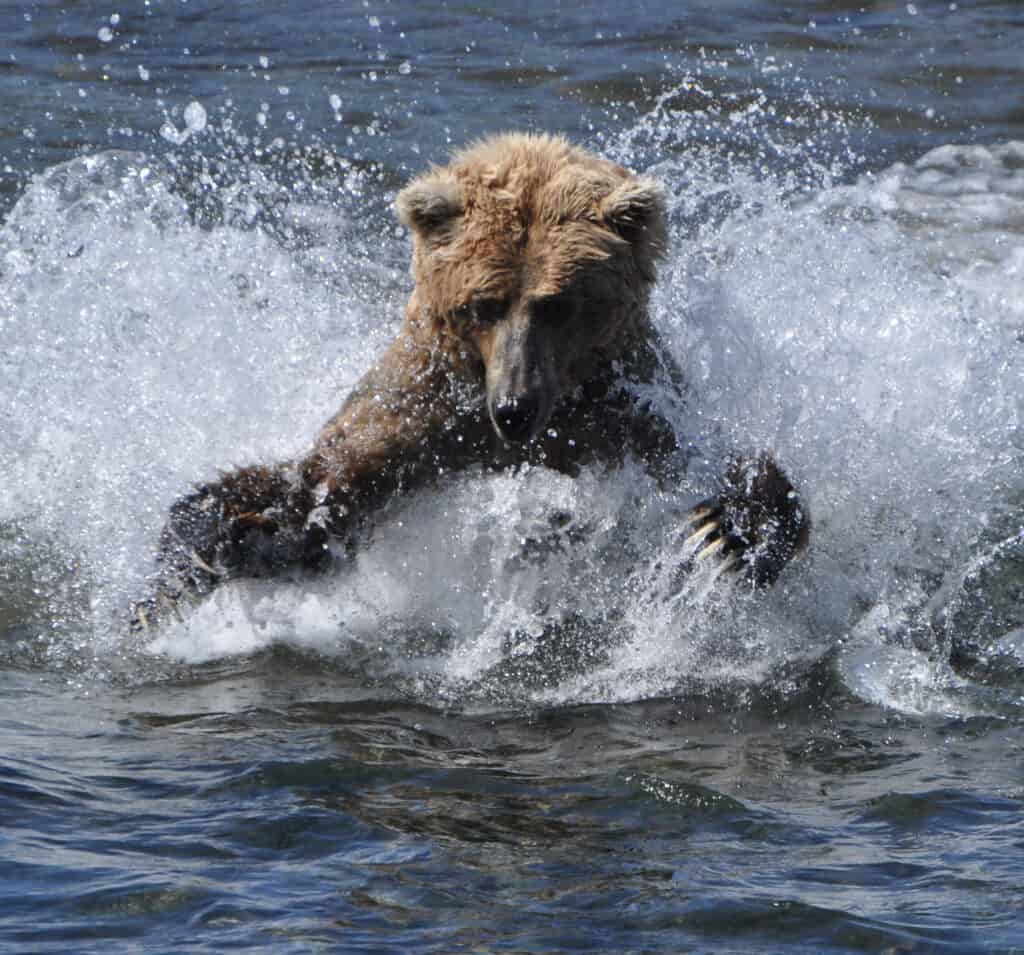
Grizzlies hunt for fish, in addition to eating berries, nuts, and roots.
©Antoni Murcia/Shutterstock.com
Grizzly Bear Dangers and Attacks
Grizzly bears are extremely lethal animals with a harsh bites. In fact, they rank among the top 10 for the strongest bites in the animal world. Even crazier, a grizzly’s teeth could chomp up a bowling ball like it’s a jolly rancher. They are powerful creatures with sturdy, muscular bodies. Their claws are super sharp, and they have been known to throw prey violently at incredible distances. They are also fast, and able to run the length of a football field in less than 10 seconds.
Grizzly bears are solitary creatures, meaning that approaching them is a terrible idea. They won’t attack if unprovoked, though. If you encounter one, keep your distance to ensure safety. When seeing grizzly cubs, under no circumstances should you approach them. Mama bear is almost always close to her cubs. While you may not see her, she probably sees you and might attack at any time.
If a grizzly bear approaches and looks like they are about to charge, a person should calmly wave their hands above their head and walk slowly backward. This body language will show the bear that the person means no harm.
There are two types of charges: bluff charges and aggressive charges. Bluff charges are not as dangerous as aggressive charges, but they sure do look intimidating. Bluff charges happen when a grizzly begins to leap toward someone but eventually stops or moves to the side. A person should not move their position during a bluff charge. Aggressive charges are not a good sign. During aggressive charges, grizzly bears will run much faster toward a person, ready to attack. A victim should play dead by lying on their stomach with their hands over their head during an aggressive charge. If the bear retreats, the person should ensure the bear is gone before standing up and walking away. The only instance in which a person should fight back against a grizzly bear is if the attack persists and worsens.
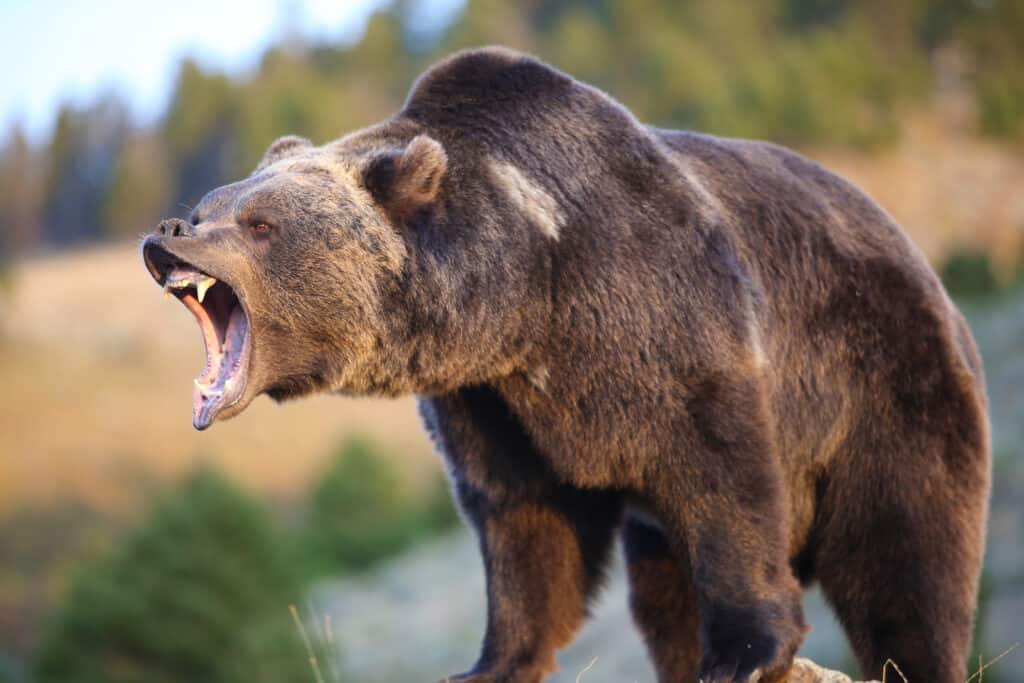
If a grizzly bear approaches and looks like they are about to charge, a person should calmly wave their hands above their head and walk slowly backward.
©Dennis W Donohue/Shutterstock.com
Grizzly Bear Fatalities and Injuries
In Yellowstone National Park, the chances of injury from a grizzly bear attack are one in 2.7 million. Injuries from a grizzly attack occur once every two decades in developed areas. In undeveloped or rural areas, they occur about once a year. Eight people have died in Yellowstone National Park due to grizzly bear attacks since its establishment in 1872. By comparison, 121 people died from drowning in Yellowstone during the same period. The probability of fatality from a grizzly bear attack in Yellowstone National Park is only higher by one incident than the probability of death from a fallen tree.
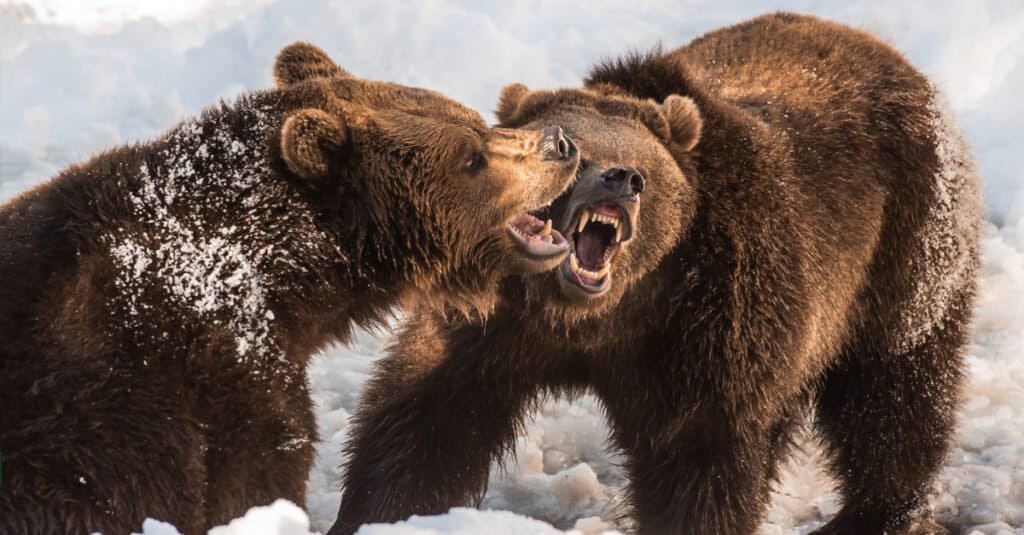
©Alexandra Giese/Shutterstock.com
Human Threats to Great White Sharks and Grizzly Bears
Although grizzly bears and great white sharks might seem like a huge threat to you, you’re a bigger threat to them. Shark populations are threatened by overfishing, manufacturing, and even soup. Soup? Yes, soup! Shark fin soup is an extremely popular dish in predominantly Asian countries, and thousands of sharks die annually for the creation of this delicacy. Some shark populations have decreased by 95%. Decreases in shark populations are harmful because sharks are highly valuable in stabilizing the ecosystem that surrounds them.
On the other hand, grizzly bears are threatened by habitat loss due to deforestation, urban development, road development, and oil and gas drilling. Many of the resources and environments that these bears need to survive have been taken by humans and utilized for transportation, residences, and financial gain. In addition, many foods and prey that the grizzly needs to survive are decreasing in abundance. This means the grizzly bear may not receive the nutrients and energy that it needs to survive.
What’s the Verdict?
Overall, an encounter with a grizzly bear would be much more dangerous than an encounter with a great white shark. Although shark attacks are more frequent than bear attacks, bear attacks are more likely to be fatal. Great whites don’t want to kill and eat humans, as they are simply confused in most cases. Grizzly bears, however, will indubitably want to kill a human encountered because they long to protect themselves and their young. Therefore, grizzly bears appear to be more lethal animals than the great white shark. Although no person would want to encounter either creature, the grizzly bear wins the “most dangerous” contest.
What Animals are More Dangerous than Grizzly Bears?
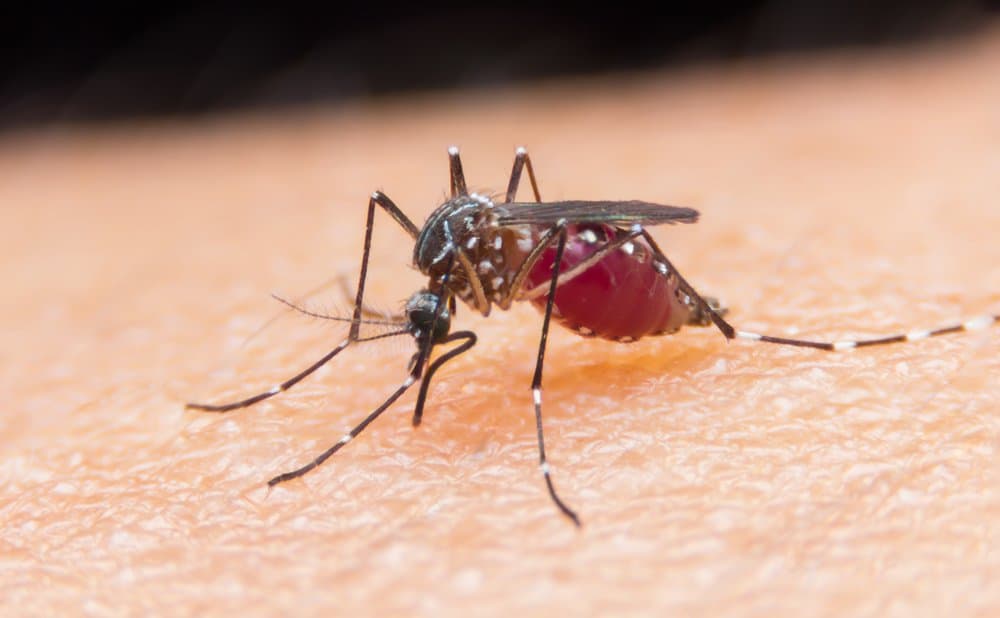
Mosquito bites may only cause an unpleasant itch for most people, but for millions these bugs are transmitters of life-threatening illness.
©AUUSanAKUL/Shutterstock.com
While their incredibly powerful jaws and razor-sharp claws may strike fear into the hearts of many people, grizzly bears account for a very small number of human deaths, as few as one a year or less on average. There are many creatures in the animal kingdom that appear inconspicuous at first, but possess a deadly potential far greater than that of a grizzly bear.
At smaller than half an inch long, the mosquito is in fact the deadliest animal to humans. These tiny insects don’t kill people directly through their bite but through the transferral of life-threatening diseases like malaria and HIV. It is estimated that as many as 1,000,000 humans die each year from diseases they contracted from mosquito bites.
The photo featured at the top of this post is ©
Sources
- Florida Museum of Natural History, Available here: https://www.floridamuseum.ufl.edu/shark-attacks/yearly-worldwide-summary/
- Smithsonian, Available here: https://ocean.si.edu/ocean-life/sharks-rays/great-white-shark
- National Geographic, Available here: https://www.nationalgeographic.com/animals/fish/facts/great-white-shark
- Florida Museum of Natural History, Available here: https://www.floridamuseum.ufl.edu/shark-attacks/odds/compare-risk/death/
- Center for Biological Diversity, Available here: https://www.biologicaldiversity.org/species/mammals/grizzly_bear/natural_history.html
- Yellowstone Bear World, Available here: https://yellowstonebearworld.com/how-aggressive-are-grizzly-bears#:~:text=Grizzly%20bears%20are%20among%20the,provoked%20or%20caught%20off%20guard
- National Park Service, Available here: https://www.nps.gov/articles/bearattacks.htm
- National Park Service, Available here: https://www.nps.gov/yell/learn/nature/injuries.htm#:~:text=For%20all%20park%20visitors%20combined,anyone%20hiking%20in%20the%20backcountry
FAQs (Frequently Asked Questions)
Which state experiences the most shark attacks?
Florida experiences the most shark attacks.
What should I do if I see a grizzly bear?
If you see a grizzly bear, do not approach it. Walk slowly backwards and speak to it calmly, showing it that you mean no harm.
How likely are shark attacks?
Chances of fatality from a shark attack are less than one in 4.3 million.
Thank you for reading! Have some feedback for us? Contact the AZ Animals editorial team.




